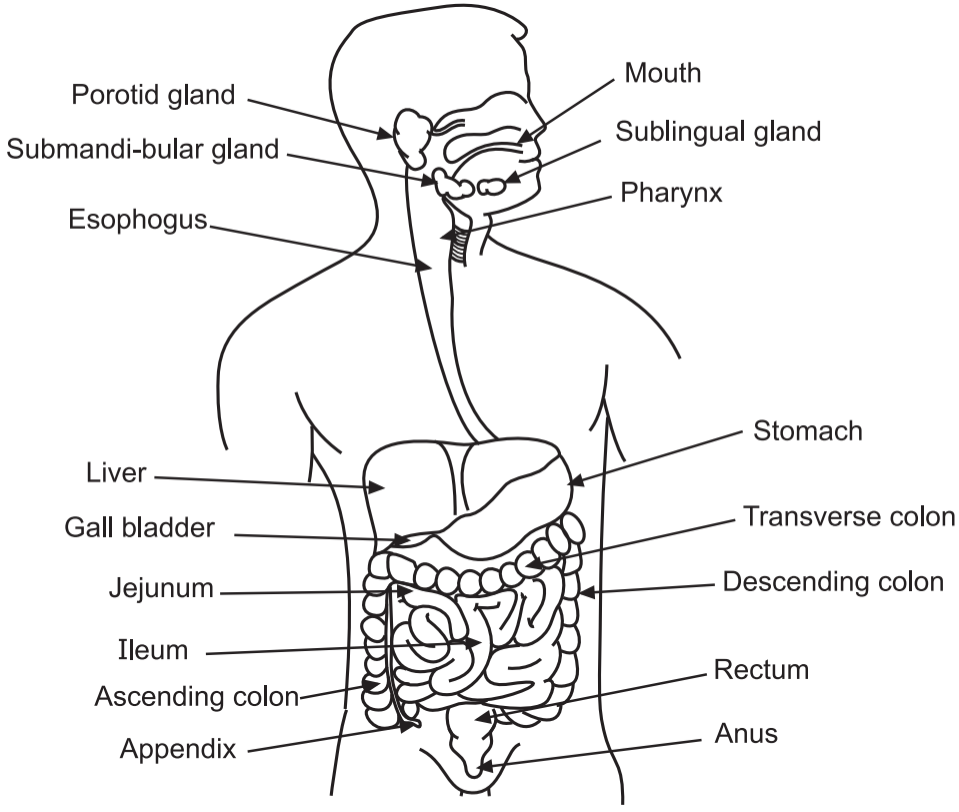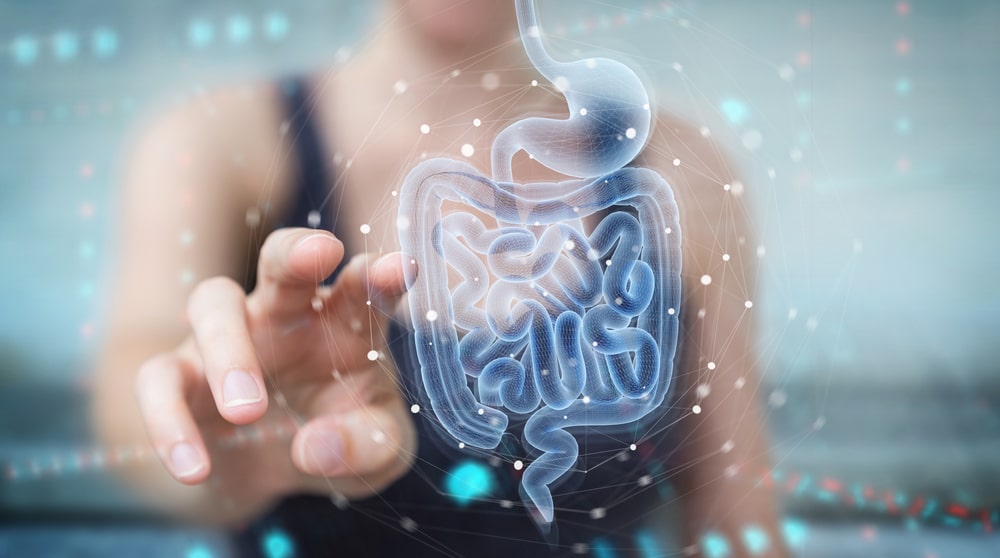Digestion and Absorption: The digestive system is composed of two parts:
- The alimentary canal or the gastrointestinal (GI) tract
- The accessory digestive organs.
(1) The alimentary canal or the gastrointestinal (GI) tract: It is a continuous tube that extends from the mouth to the anus.
Organs of the alimentary canal or the gastrointestinal (GI) tract are:
- Mouth
- Pharynx
- Esophagus
- Stomach
- Small Intestine
- Large Intestine
The length of the alimentary canal is about 5–7 meters (16.5–23 ft).

2. The accessory Digestive Organs: The accessory digestive organs include:
- Teeth
- Tongue
- Salivary glands
- Liver
- Gall bladder
- Pancreas
Functions of Digestive System:
1. Ingestion: This process involves taking foods and liquids into the mouth (eating).
2. Secretion: Alimentary canal and accessory digestive organs release water, acid, buffers, and various enzymes space of the canal.
3. Mixing and propulsion: Alternating contractions and relaxations of smooth muscle in the walls of the GI tract mix. Food material and various secretions from the alimentary canal and accessory digestive organs are mixed with the movement of the GI tract.
4. Digestion: The food which we eat is broken down into small molecules with the help of acid, enzymes, etc., this process is called digestion.
5. Absorption: The small molecules, ions are taken through lumen cells of the GI tract to blood, this is called absorption.
6. Defecation: Indigestible, waste material, which cannot be absorbed is excreted out through the anus. This process is called defecation. The waste material which is thrown out is called feces.
Digestive Enzymes
Table of Contents
Digestive enzymes are produced by the salivary glands, tongue, stomach, pancreas, and small intestine. These enzymes are responsible for catalyzing various reactions in the alimentary canal.
The various enzymes secreted by various parts of the GI tract and their roles are as follows:
1. Salivary amylase: It is secreted by salivary glands. This enzyme is responsible for the breakdown of starch.
2. Lingual lipase: It is secreted by lingual glands in the tongue. This enzyme is responsible for the breakdown of triglycerides.
3. Pepsin: It is secreted by the stomach. This enzyme is responsible for the breakdown of proteins.
4. Gastric lipase: It is secreted by the stomach. This enzyme is responsible for the breakdown of triglycerides.
5. Pancreatic amylase: It is secreted by the pancreas. This enzyme is responsible for the breakdown of starch.
6. Trypsin, chymotrypsin, carboxypeptidase, and elastase: These enzymes are secreted by the pancreas. These enzymes are responsible for the breakdown of proteins.
7. Pancreatic lipase: It is secreted by the pancreas. This enzyme is responsible for the breakdown of triglycerides.
8. Ribonuclease and deoxyribonuclease: These enzymes are secreted by the pancreas. These enzymes are responsible for the breakdown of nucleic acids.
9. Dextrinase, maltase, sucrase, and lactase: These enzymes are secreted by the small intestine. These enzymes are responsible for the breakdown of carbohydrates.
10. Aminopeptidase and dipeptidase: These enzymes are secreted by the small intestine. These enzymes are responsible for the breakdown of proteins.
11. Nucleosidases and phosphatases: These enzymes are secreted by the small intestine. These enzymes are responsible for the breakdown of nucleotides.
Digestion
Digestion in Mouth:
- Chewing of food material which we take in mouth, is carried out with the help of the tongue. The food material is minced by the teeth and mixed with saliva. This activity leads to softening of the food which is too easy to swallow. This softened mass of food is called a bolus (lump).
- Food material starts dissolving in the water in saliva.
- Salivary amylase, which is secreted by the salivary glands, initiates the breakdown of starch.
- Lingual lipase is secreted by lingual glands in the tongue. This enzyme becomes activated in the acidic environment of the stomach and thus starts to work after food is swallowed.
Digestion in the Stomach:
- After food enters the stomach, movement of the stomach mixes food with secretions of the gastric glands and reduces it to a soupy liquid called chyme.
- Digestion by salivary amylase continues in the stomach. The acidic environment in the stomach activates lingual lipase, which breaks triglycerides into fatty acids and diglycerides.
- Pepsin in the stomach digests the proteins.
- Gastric lipase breaks the short-chain triglycerides in fat molecules.
Digestion in the Small Intestine:
- Carbohydrates like sucrose, lactose, and maltose are broken down in the small intestine.
- Sucrase breakdowns sucrose into a molecule of glucose and a molecule of fructose.
- Lactase digests lactose into a molecule of glucose and a molecule of galactose.
- Maltase breaks maltose and maltotriose into two or three molecules of glucose, Digestion of carbohydrates ends with the production of monosaccharides, which the digestive system can absorb.
- Protein digestion is completed by two peptidases in the brush border: aminopeptidase and dipeptidase.
- Aminopeptidase cleaves off the amino acid at the amino end of a peptide.
- Dipeptidase splits dipeptides (two amino acids joined by a peptide bond) into single amino acids.
Two enzymes called nucleosidases and phosphatases breaks down pentoses, phosphates, and nitrogenous bases.
Absorption
- The route of these digested nutrients from the alimentary canal or gastrointestinal tract into the blood or lymph is called absorption.
- The materials are absorbed through processes like diffusion, facilitated diffusion, osmosis, and active transport.
- About 10% of nutrients are absorbed in the stomach and large intestine while the remaining 90% of nutrients are absorbed in the small intestine.
Assimilation of Food
- Assimilation of food starts only after digestion of food. One has to remember that food digested is not food estimated. Carbohydrates and proteins are digested first, in the stomach by the action of strong acid and enzymes, while the fats are digested to fatty acids in the intestine.
- Assimilation takes place only in the small intestine. The intestine is provided with tiny projections known as microvilli on the preface of the cells lining the intestine which are known as epithelial cells. These epithelial cells take nutrients from the intestine and pump them into the blood, where it is distributed to the body for growth and repair.
Make sure you also check our other amazing article on : The Living World
